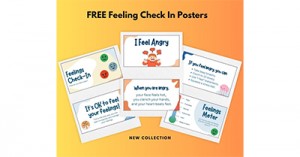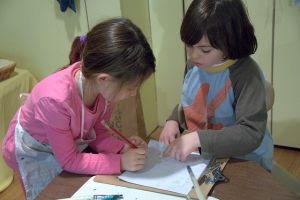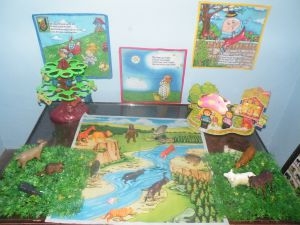Helping toddlers and preschoolers build emotional vocabulary is like giving them a toolbox for life—they learn to name what they feel, which helps them express themselves, regulate emotions, and connect with others. Here are some engaging, developmentally appropriate strategies and games to teach emotional vocabulary.
Everyday Strategies
- Name emotions in the moment: “You look frustrated that the block tower fell.” This models emotional language in context.
- Use visual aids: Emotion cards, mirrors, or a “feelings wheel” can help children match words to facial expressions.
- Read books with emotional themes: Pause to ask, “How do you think she feels?” or “What would you do?”
Creative Activities
- Feeling Faces Collage: Let children cut out or draw faces showing different emotions. Label each one together.
- Emotion Charades: Act out feelings like “excited,” “nervous,” or “proud” and have others guess.
- Color Your Feelings: Invite children to choose colors that match how they feel and explain their choices.
Play-Based Tools
- Emotion Dolls or Puppets: Use them in dramatic play to explore scenarios like “What made the puppet feel left out?”
- Feeling Toolbox: Create a kit with sensory items (like squishy balls or calming jars) labeled with emotions they help soothe.
Language in Action
- Emotion Echoing: When a child expresses a feeling, echo it back with a richer word. “You’re mad” becomes “You’re feeling frustrated because your turn ended.”
- Feelings Forecast: Before transitions, say things like “Some friends might feel disappointed when we pack away. That’s okay—we’ll play again tomorrow.”
Body Clues
- Name the Clue: “Your fists are tight and your face is scrunched—are you feeling angry?” This helps children connect physical sensations with emotions.
- Mirror Moments: Use a mirror to explore expressions together. “Show me your ‘worried’ face. What does your mouth do?”
Snack-Time Talk
- Emotion of the Day: Introduce a new feeling word during snack. “Today’s word is ‘proud.’ When do you feel proud?”
- Taste & Feel: Link food to feelings. “This orange is sweet—like how you felt when your friend shared!”
Playful Prompts
- Toy Talk: Narrate play with emotional language. “The teddy looks lonely. What could help him feel better?”
- Cleanup Check-In: “How are you feeling about packing away? A little tired? A bit grumpy?”
Expand Vocabulary Gradually
Start with core feelings—happy, sad, mad, scared—and build toward nuanced ones like “disappointed,” “proud,” or “worried.”
Games To Teach Emotional Vocabulary
Games are a brilliant way to help toddlers and preschoolers explore emotions in a safe, playful way. Here are some engaging options that blend movement, creativity, and reflection.
- Emotion Charades
Children act out feelings like “excited,” “nervous,” or “proud” without words while others guess. It builds empathy and helps them read body language.
- Emotion Sorting
Use cards with faces or emojis and ask children to group them by similar feelings. You can add a twist by linking them to real-life scenarios: “Which face shows how you feel when Mum picks you up?”
- Feelings, Pebbles
Paint pebbles with different expressions. Children pick one and share a time they felt that way. These can also live in your “feeling toolbox” for daily check-ins.
- Musical Emotions
Play music and pause it randomly. Children freeze and show an emotion with their face or body. You can call out a feeling or let them choose.
- Puppet Play
Use puppets to act out social situations—like losing a toy or making a new friend—and explore how characters feel and respond.
- Emotion Jars
Children shake glitter jars to represent “stormy” feelings, then watch them settle as they calm down. It’s a visual metaphor for emotional regulation. Feelings Bingo
Create bingo cards with emotion faces or words. As you describe a scenario (“You lost your teddy”), children cover the matching emotion.
Reflective Prompts
- “What made you feel that way?”
- “What could help you feel better?”
- “Can you show me with your face or body?”
Further Reading
Teaching Children About Emotions
Encouraging Children to Express Emotions Appropriately
30 Emotional Regulation Activities For Toddlers and Preschoolers
Emotional Awareness and Self-Regulation Skills For Children







 Open ended questions cannot be responded to with one word answers such as yes or no. These types of questions enables a child to provide
Open ended questions cannot be responded to with one word answers such as yes or no. These types of questions enables a child to provide During your child’s preschool years, an important milestone begins to emerge. This is the development of pre-writing skills. Pre-writing skills are used to encourage, develop
During your child’s preschool years, an important milestone begins to emerge. This is the development of pre-writing skills. Pre-writing skills are used to encourage, develop Open ended materials enables children to play freely. They are objects that have no rules to follow, use or function. Raw materials that can be
Open ended materials enables children to play freely. They are objects that have no rules to follow, use or function. Raw materials that can be An Acknowledgment of the Country is a way of showing respect for the Traditional Owners and can be given by both non-Indigenous people and Aboriginal
An Acknowledgment of the Country is a way of showing respect for the Traditional Owners and can be given by both non-Indigenous people and Aboriginal Language plays an important role in a child’s development. It enables a child to communicate effectively with their family, learn at school, socialize with friends,
Language plays an important role in a child’s development. It enables a child to communicate effectively with their family, learn at school, socialize with friends, Like adults, children have to deal with their own stress in life. Moving house, starting a new school, preparing for a new sibling - these are
Like adults, children have to deal with their own stress in life. Moving house, starting a new school, preparing for a new sibling - these are Playdough is such a versatile material. It provides numerous benefits to children as they manipulate it, it is safe and soothing and provides children with
Playdough is such a versatile material. It provides numerous benefits to children as they manipulate it, it is safe and soothing and provides children with Teaching children about sustainability enables them to appreciate and respect the natural environment. Early childhood services can provide meaningful hand on learning experiences in order
Teaching children about sustainability enables them to appreciate and respect the natural environment. Early childhood services can provide meaningful hand on learning experiences in order Recycling is an important concept that teaches children to care for the environment. It encourages children to be responsible and show a growing appreciating for
Recycling is an important concept that teaches children to care for the environment. It encourages children to be responsible and show a growing appreciating for When children apply paint to paper, glue things together, or pound a lump of clay, they experiment with colour, shape design and texture.
When children apply paint to paper, glue things together, or pound a lump of clay, they experiment with colour, shape design and texture.



